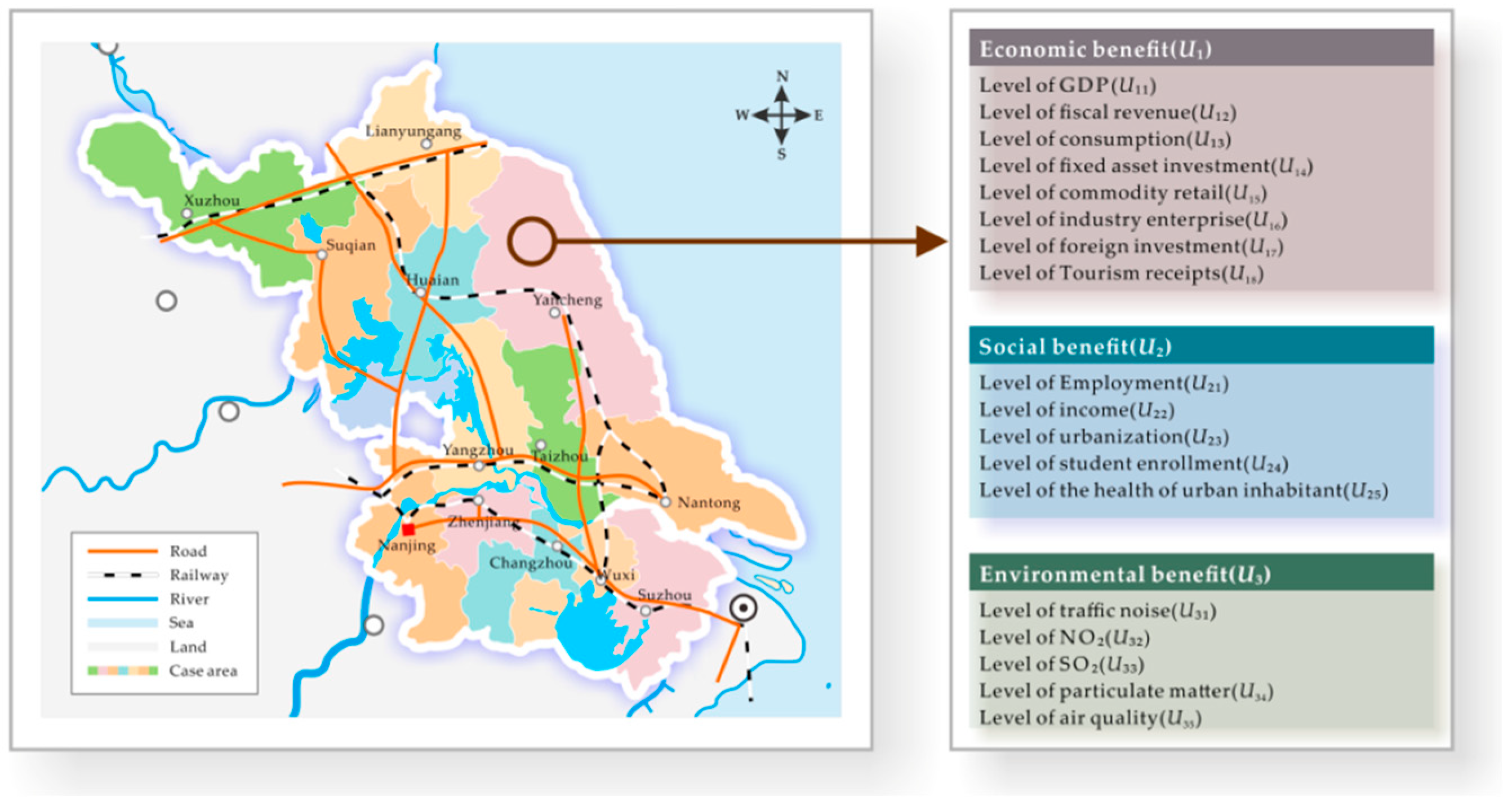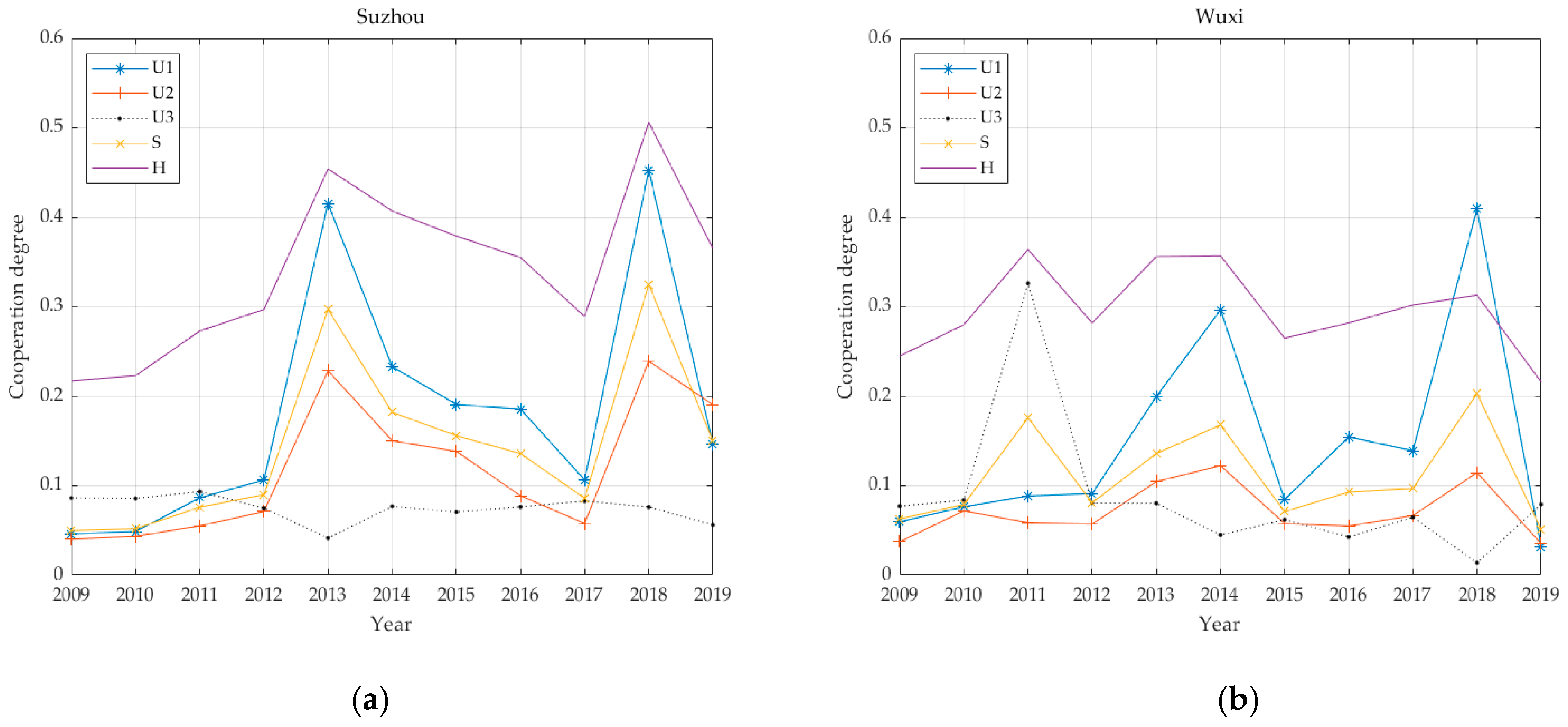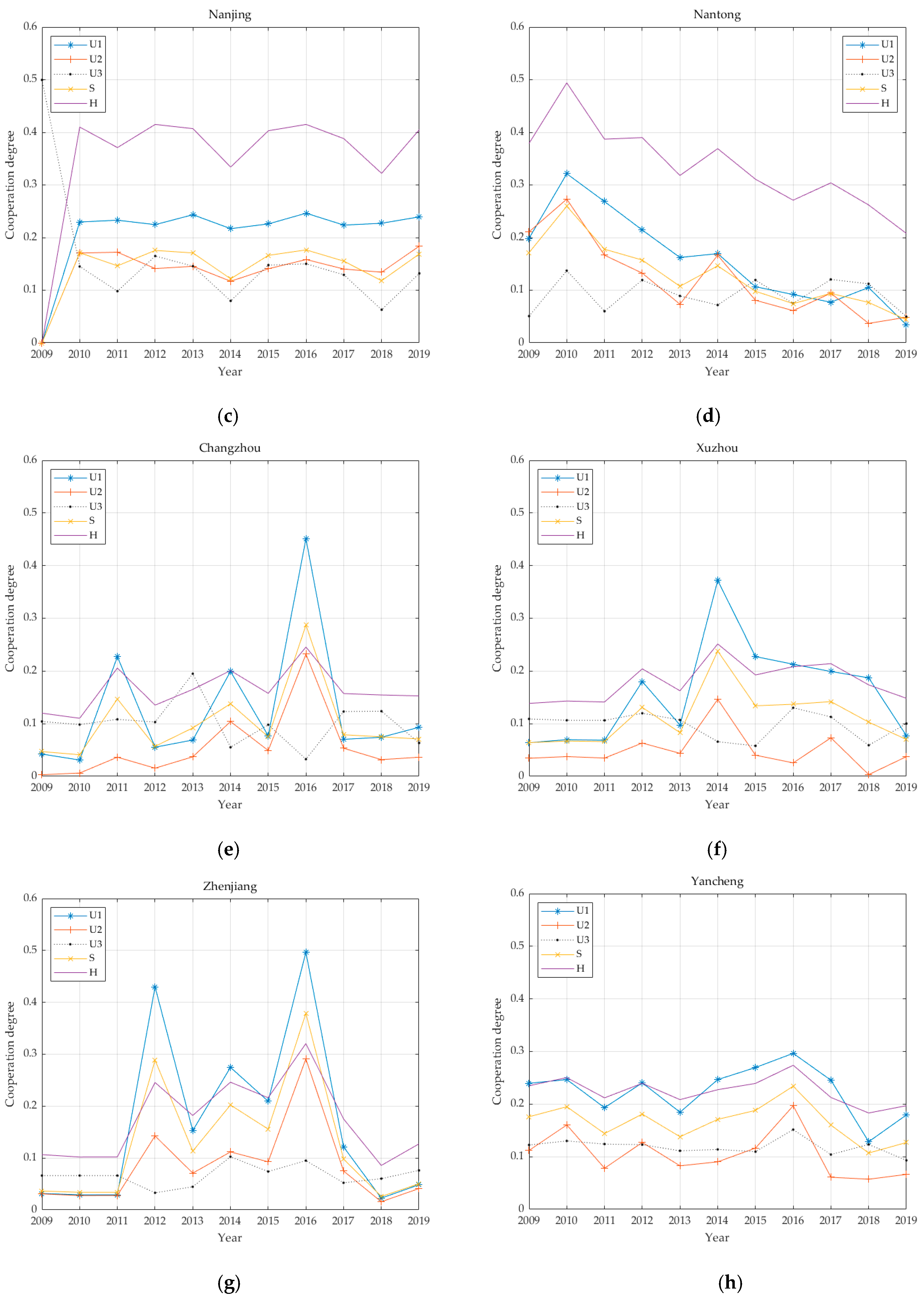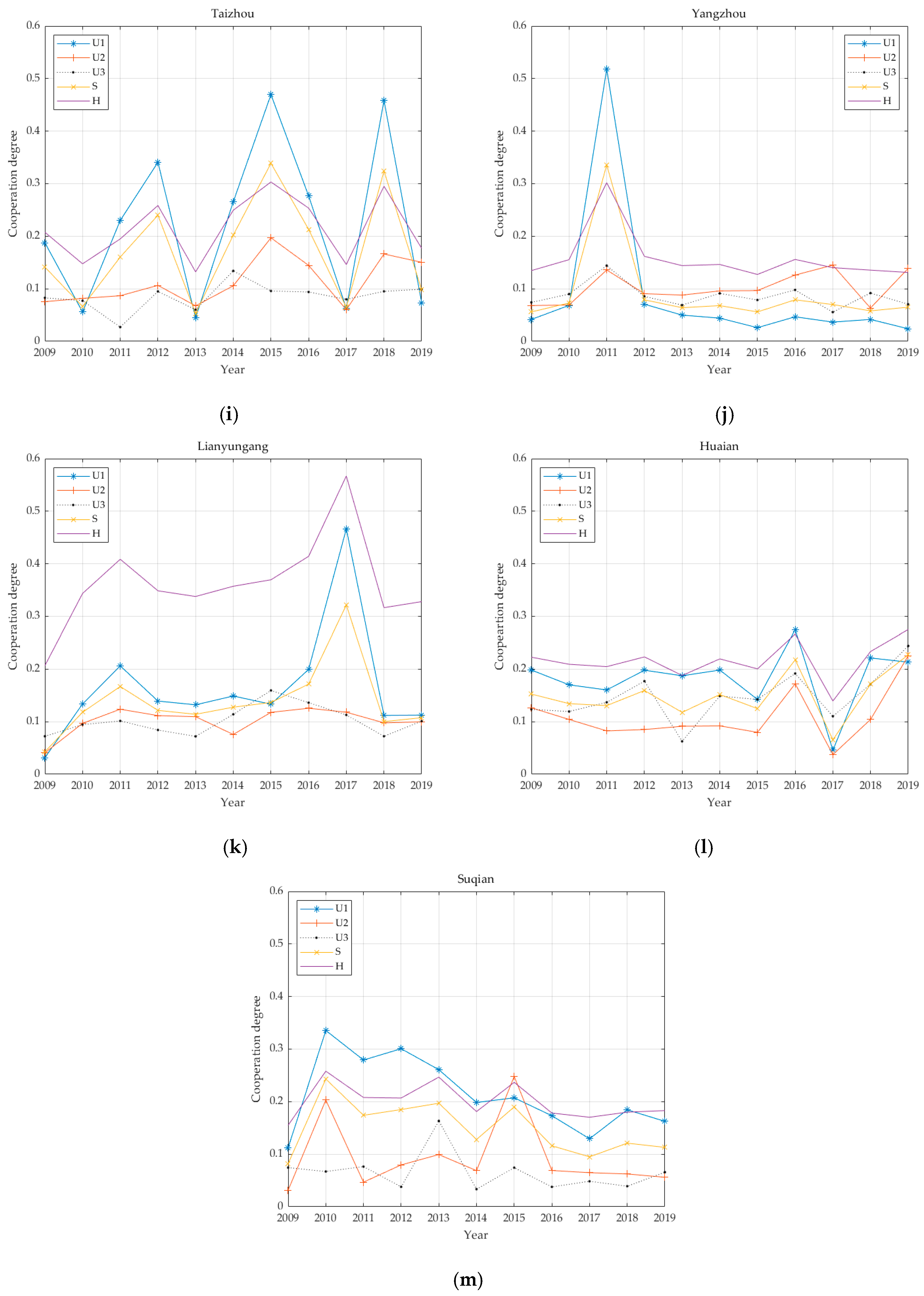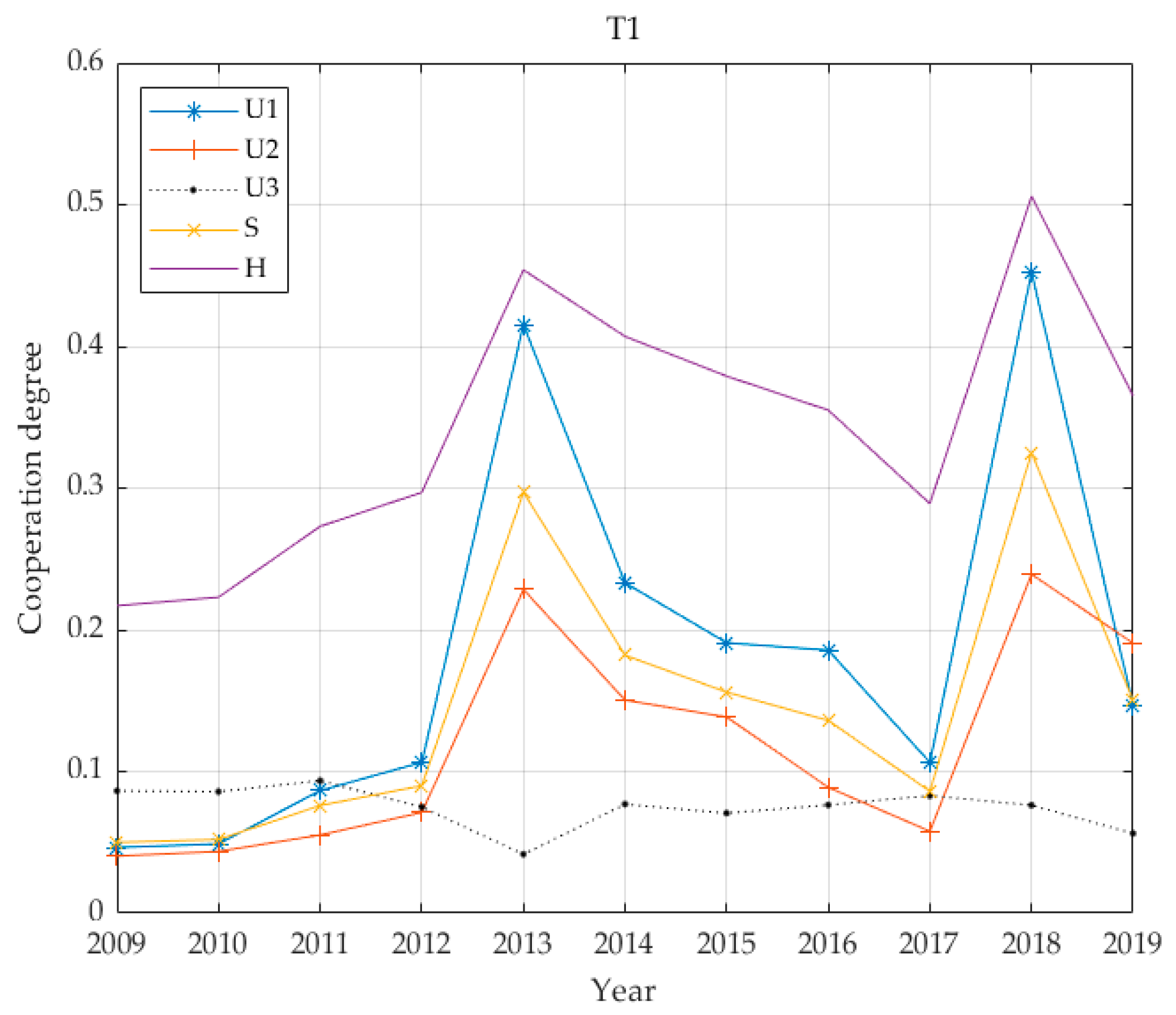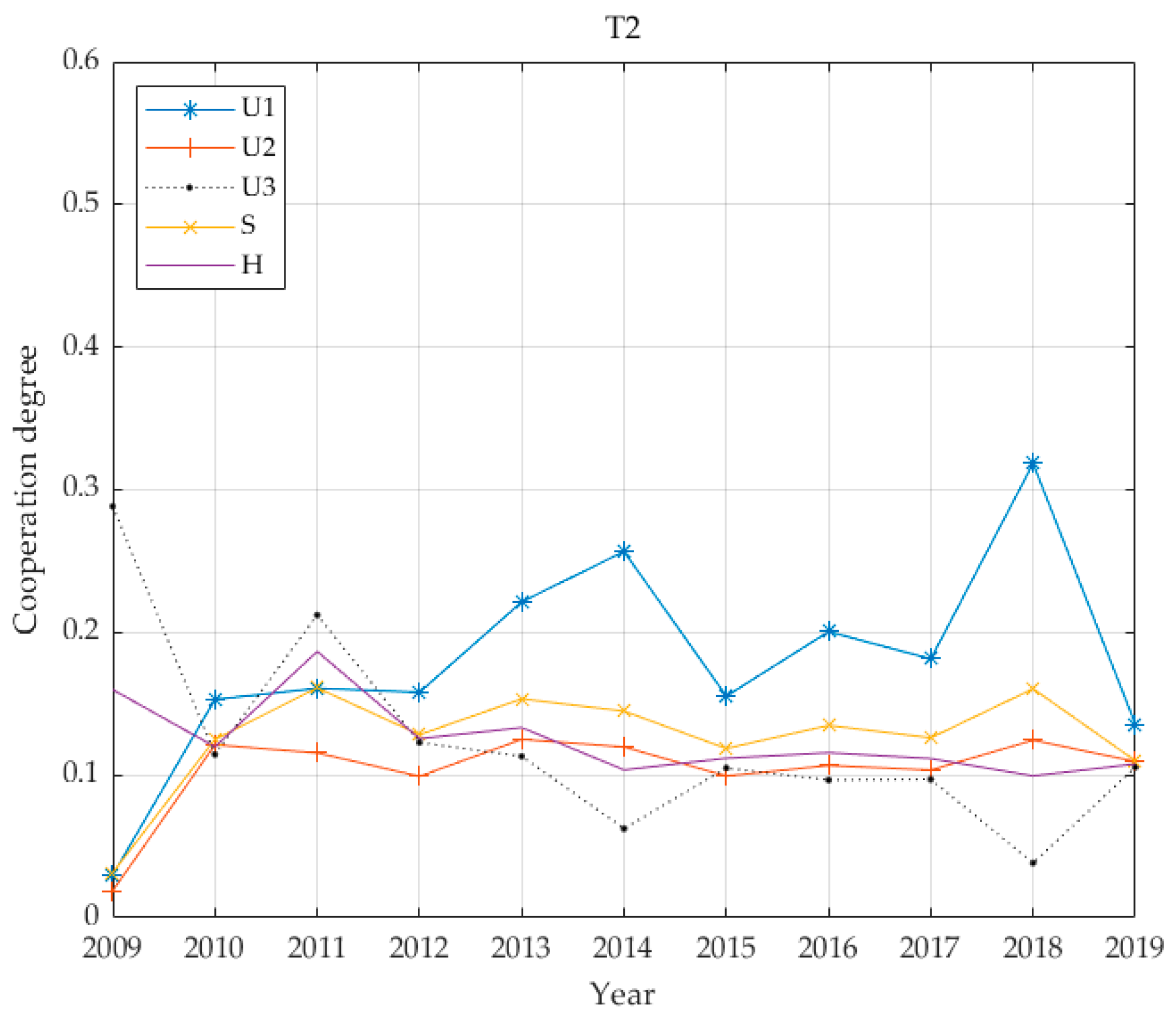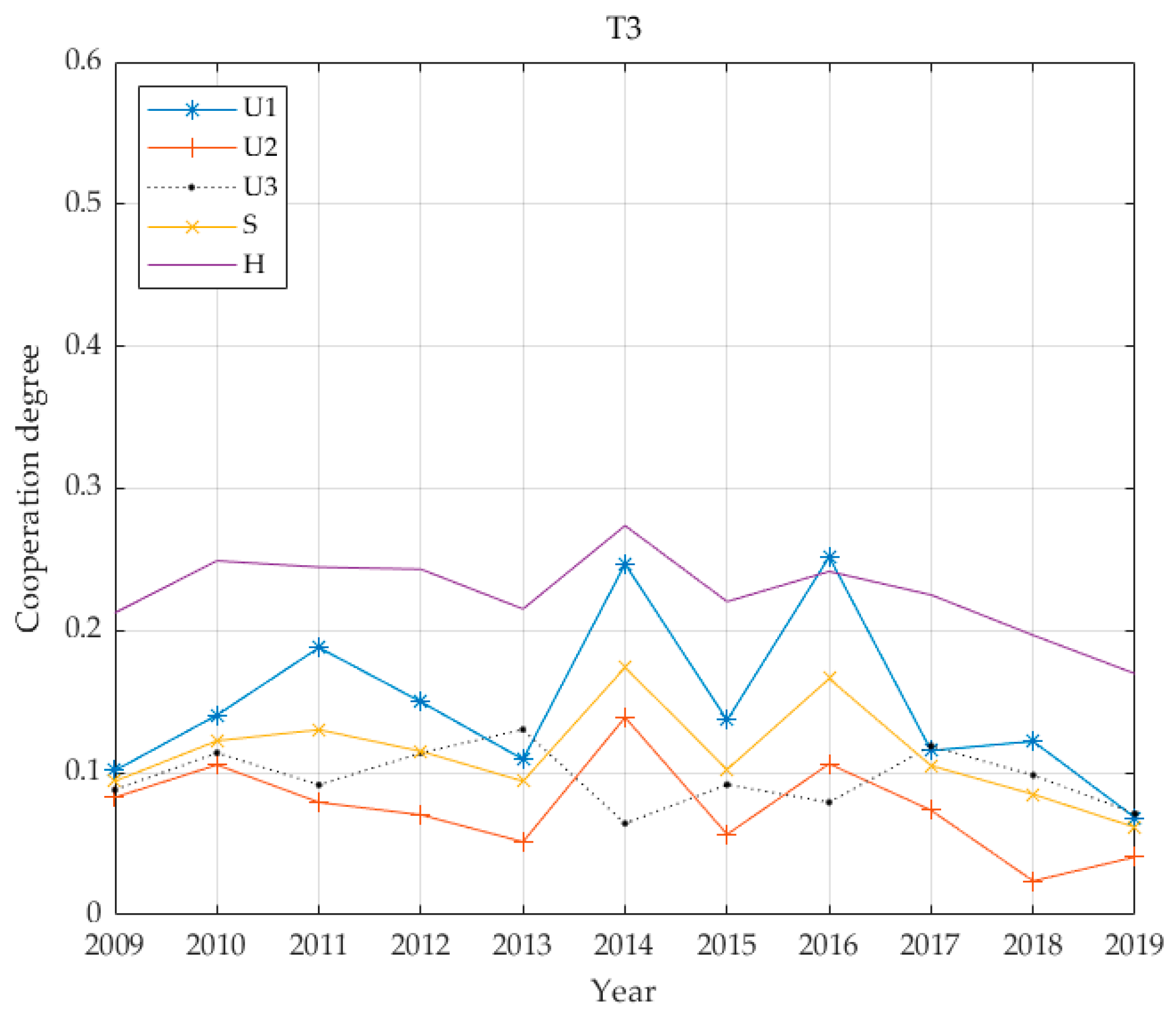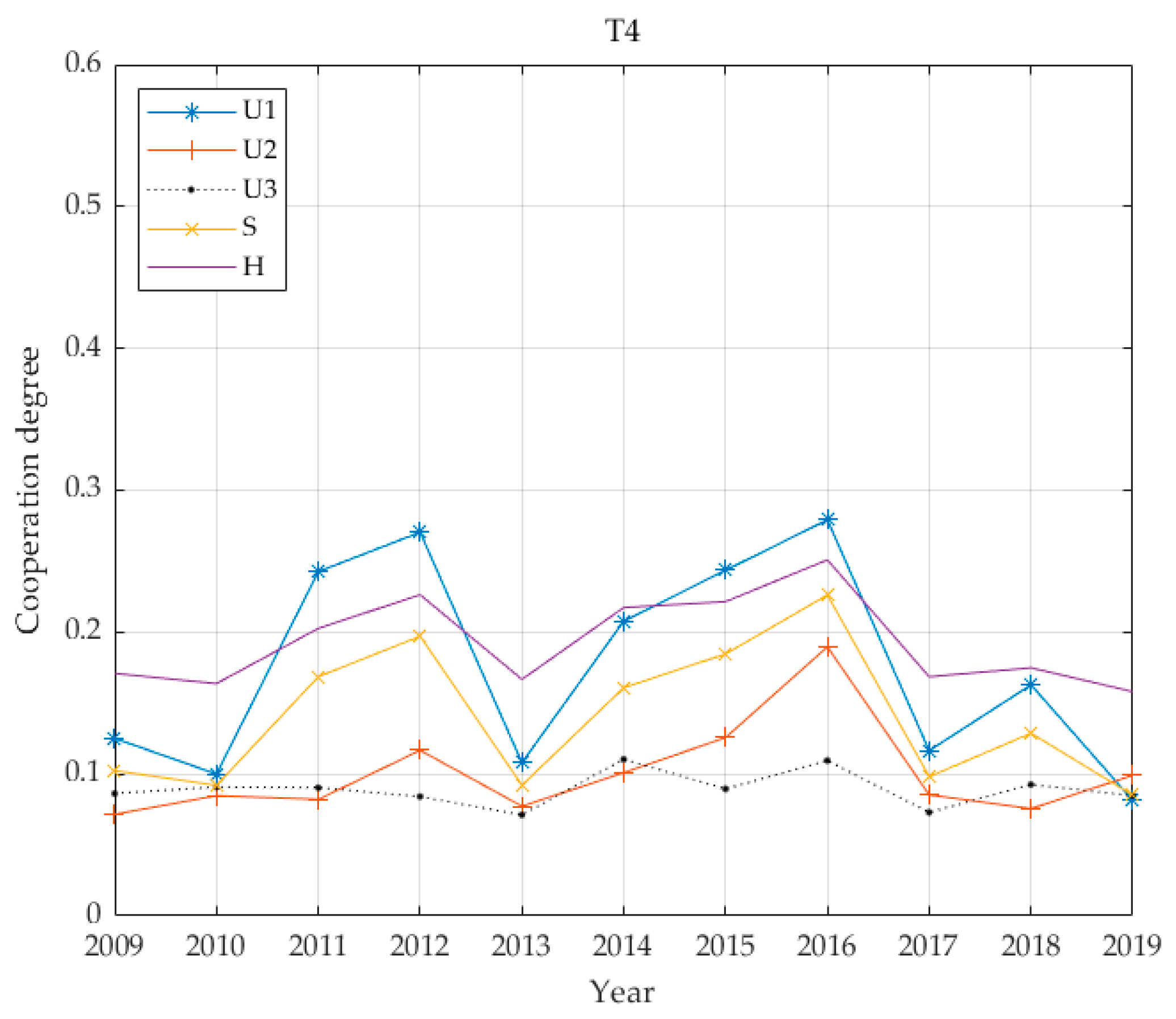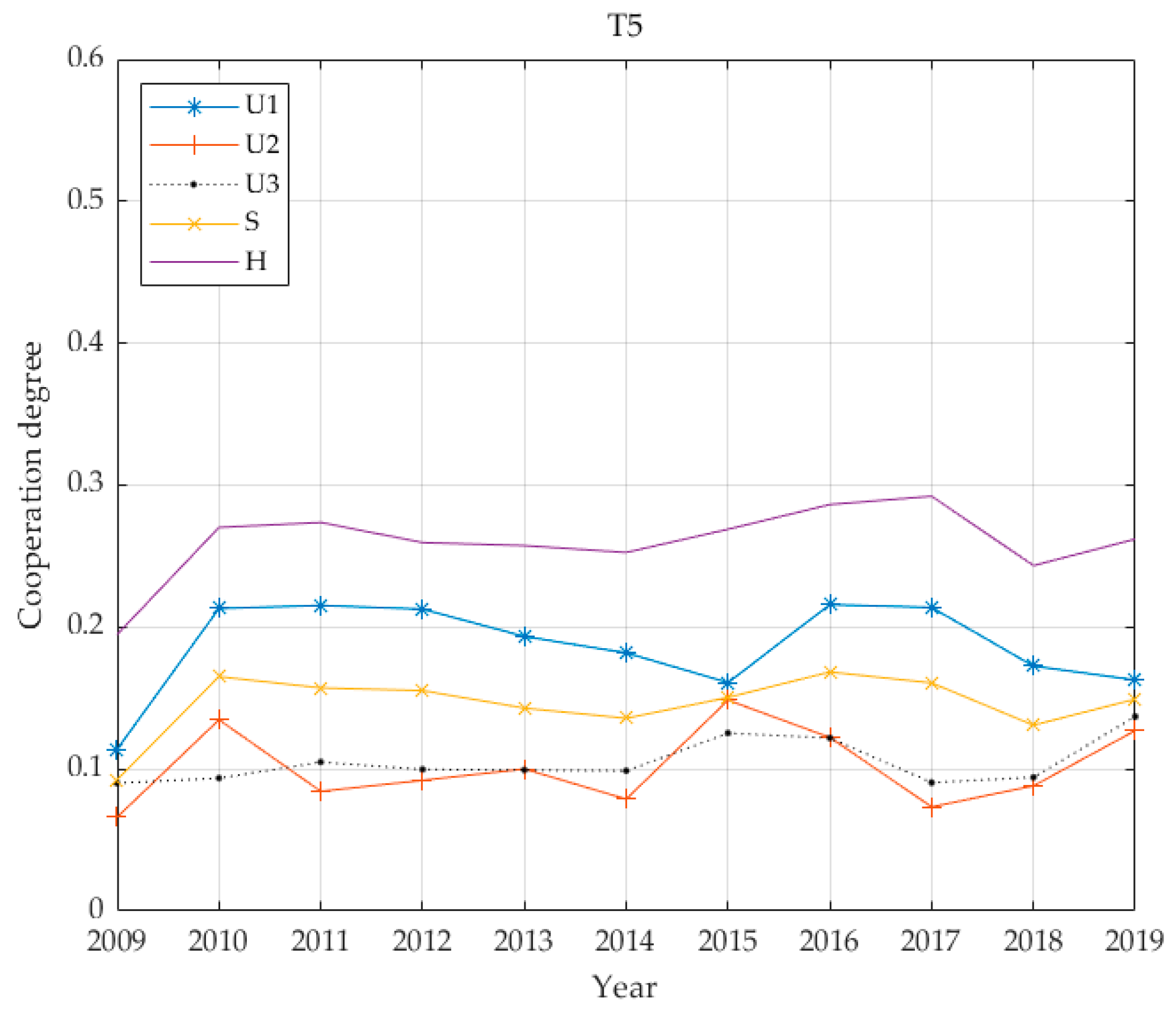4.2. Economic Segment
The systematic clustering method considers the clustered samples or variables as a group, determines the similarity statistics between the grades, selects the closest two or more grades to incorporate into a new grade, calculates the new class and finally, for the similarity statistics among other categories, the closest two or several groups are selected and incorporated into a new category until all samples or variables are incorporated into one category.
After clustering, in
Figure 3, the abscissa is the Euclidean distance and the ordinate is the index of 13 cites individually. Using the 10-year GDP data for the sample cities, SPSS software was employed for systematic clustering and the result was divided into the five grades denoted as T1–T5. T1 includes Suzhou; T2 includes Nanjing and Wuxi; T3 includes Nantong, Changzhou and Xuzhou; T4 includes Yangzhou, Yancheng, Taizhou and Zhenjiang; and T5 includes Huaian, Lianyungang and Suqian.
From the data in
Table 4 and the horizontal comparison, it can be seen that the economic benefits of PT infrastructure in cities of all levels are relatively significant, and there are multiple relationships existing between social and environmental benefits. In the longitudinal comparison, T1 cities exhibit the highest economic benefits and the lowest environmental benefits; T2 cities have the highest environmental benefits; T3 cities show the smallest difference among economic, social and environmental benefits; and T4 and T5 cities have the highest economic benefits and the lowest social benefits. The trend for environmental benefits is flat, but the level is not high. Generally, urban cities rely on PT in very different ways than rural cities. Herein, there is an effect emerging of “less developed” cities versus “more developed” cities having different needs from transportation. For example, the types of jobs comprising the economic base for the city, i.e., the requirements that drive transportation in the first place, can be different depending on the behaviours in that city.
As illustrated in
Figure 4, the benefit characteristics of the PT infrastructure in the T1 cities are as follows: economic benefits are primary, social benefits are subordinate and environmental benefits are low; the coordination degree is 0.34; and the level is four. This corresponds to slightly unbalanced development. As part of the development of transportation resources, the length of the PT infrastructure road network increased between 2009 and 2019. At the same time, the GDP of Suzhou has also increased annually. Therefore, the weight of the economic benefit within the T1 urban PT infrastructure benefits is relatively large. With the exception of environmental benefits, other benefits increased slowly from 2009 to 2011. In 2012, however, Suzhou authorities began operating a night bus. In 2013, five transportation companies in Suzhou consolidated resources and merged into a single PT company. Since then, the basic, economic and social benefits of urban PT have increased rapidly, reaching first place among the groups for the period 2009–2019. In 2016, Suzhou rail transit accounted for 16.3% of public passenger transport. By 2018, rail transit accounted for 33.2% of public passenger transport, a level 2.03 times that of 2016. Rail transit is obviously developing rapidly. The basic benefit of PT was 0.3250, the economic benefit was 0.4523 and the social benefit was 0.2392 and rising rapidly, reaching the second rank for 2009–2019 and exhibiting the greatest growth over the ten years.
The benefits of PT infrastructure in the T2 cities are characterised in
Figure 5. Economic benefits are the mainstay; social benefits and environmental benefits are approximately equal and their levels are low. The changes in social benefits are gradual, the environmental benefits vary widely and the overall coordination degree is 0.1249. In the second level, there is seriously unbalanced development and it is at a low level. Nanjing authorities opened Metro Line 1 in 2005 and Metro Line 2 in 2010. Between 2010 and 2011, the basic benefits of urban PT increased, and the environmental benefits have risen sharply. It is inferred that the use of rail transit has reduced the number of private car trips. As a result of reducing carbon emissions and greenhouse gas emissions, the air quality rate has improved. In 2014, Wuxi Metro (Lines 1 and 2) was put into operation, Nanjing opened the first tram in Jiangsu Province and Metro Line 10, S8, in the same year. The economic benefits of urban PT infrastructure in the T2 cities have reached their peak, but the environmental benefits have dropped significantly. The reason for this is that the convenience of transportation has greatly promoted economic development, corporate profits have risen, employment rates have risen, per capita disposable income has increased and private car travel has increased, and this has greatly reduced environmental benefits. In 2015, Nanjing Metro Line 3 was put into operation, with a total length of 44.9 km. In early 2017, Metro Line 4 was put into operation. At the end of 2017, Nanjing opened the Kirin tram. Wuxi’s GDP, fiscal revenue, tourism economy and industrial profits have risen sharply. At this time, the economic benefits of PT infrastructure have reached a ten-year maximum.
As illustrated in
Figure 6, the benefits of PT infrastructure in T3 cities include economic impact as primary benefit, followed by social benefits and then environmental benefits, and the overall coordination degree is 0.2266. Development is moderately unbalanced, and the general trend for PT infrastructure exhibits the greatest impact from economic benefits, moderate impact from social benefits and weaker impact from environmental benefits.
The benefits of PT infrastructure in T4 cities rank are given in
Figure 7. Economic benefits are first, followed by social benefits and then environmental benefits, with an overall coordination degree of 0.1929, and development is seriously unbalanced. The general trend for PT infrastructure benefits shows that the maximum impact comes from economic benefits and that this impact differs greatly from that of social benefits, while environmental benefits have not changed much in the past decade. The analysis shows that rail transit in the T4 cities is still in its infant stage, and PT has not provided an alternative to private travel. Therefore, environmental benefits have developed slowly. The transportation policies of T4 cities focus primarily on economic benefits, and there is still room for improvement in the economy without considering sustainable development and coordinated development.
The benefits of PT infrastructure in T5 cities are shown in
Figure 8. Economic benefits are greatest, social benefits and environmental benefits are approximately equal and the overall coordination degree is 0.2601; the level is three, corresponding to moderately unbalanced development. In general, the trend in PT infrastructure benefits runs closest to that of economic benefits, roughly similar to social benefits, and slightly closer to environmental benefits, and the level of coordinated development is acceptable.
Based on the empirical investigation above, it is possible that the spikes and dips in certain years are derived from various metro lines put into operation, as in Nanjing and Wuxi cities. The fluctuations in most cites have similar reasons of new construction. Hence, from the viewpoint of the study, it is normal for these fluctuations to occur. In addition, these investments indeed include just new construction.
From the above five benefit curves (
Figure 5,
Figure 6,
Figure 7 and
Figure 8), the benefits of urban PT in the T1 grade are identical to economic benefits and social benefits, whereas the cities in the T2 grade do not reflect the characteristics described above. However, cities in the T3–T5 grades have changed significantly, and the basic and economic benefits of urban PT are basically the same. With increases in Tl grade, this feature becomes increasingly obvious.
From the perspective of coordinated development, all coordination degrees for all levels of cities are below 0.4; the highest average is 0.34 for T1, while the lowest is 0.1249 for T2. The values for T3 and T5 are relatively close at 0.2266 and 0.2601, respectively, and the value for T4 is 0.1929. The city with the highest economic level has the highest degree of coordination. The city with the second highest economic level has the lowest degree of coordination. In the benefit structure for this level of city, the proportion of environmental benefits is greater than 0.4. It is assumed that this value is due to the lagging coordination realised during this transitional period. The degree of coordination between T3 and T5 cities is similar, and the benefit structures for these cities give highest priority to economic benefits while social and environmental benefits are accorded basically equal emphasis. The common feature of the PT system is that it has not yet been developed to include rail transportation and the advantage of leading economic benefits has not realised.
